Analysis of Maintenance Engineering and Production Systems for EVs
VerifiedAdded on 2023/06/10
|29
|6693
|499
Report
AI Summary
This report delves into the maintenance engineering aspects of electric vehicle (EV) production systems. It begins with an executive summary highlighting the rapid growth of the EV industry and the decreasing costs of battery technology. The report emphasizes the role of Pulse Width Modulation Motor Control circuits and battery management systems in modern EVs, particularly for urban transportation. It explores the technical feasibility and affordability of electric cars, comparing them to traditional vehicles in terms of cost and reliability. Key areas of focus include the development of lightweight EVs using brushless direct current motors and the importance of battery management systems for lithium-ion batteries. The report also discusses battery monitoring units, control area networks, thermal management systems, and various components of an electrical vehicle. Furthermore, the report looks at technical problem-solving techniques (TRIZ) and wear reduction methods, hardware considerations, results and discussions, and concludes with recommendations for future advancements in the field. Desklib provides access to this and other solved assignments to aid students.

MAINTENANCE ENGINEERING
PRODUCTION SYSTEM
By Name
Course
Instructor
Institution
Location
Date
PRODUCTION SYSTEM
By Name
Course
Instructor
Institution
Location
Date
Paraphrase This Document
Need a fresh take? Get an instant paraphrase of this document with our AI Paraphraser
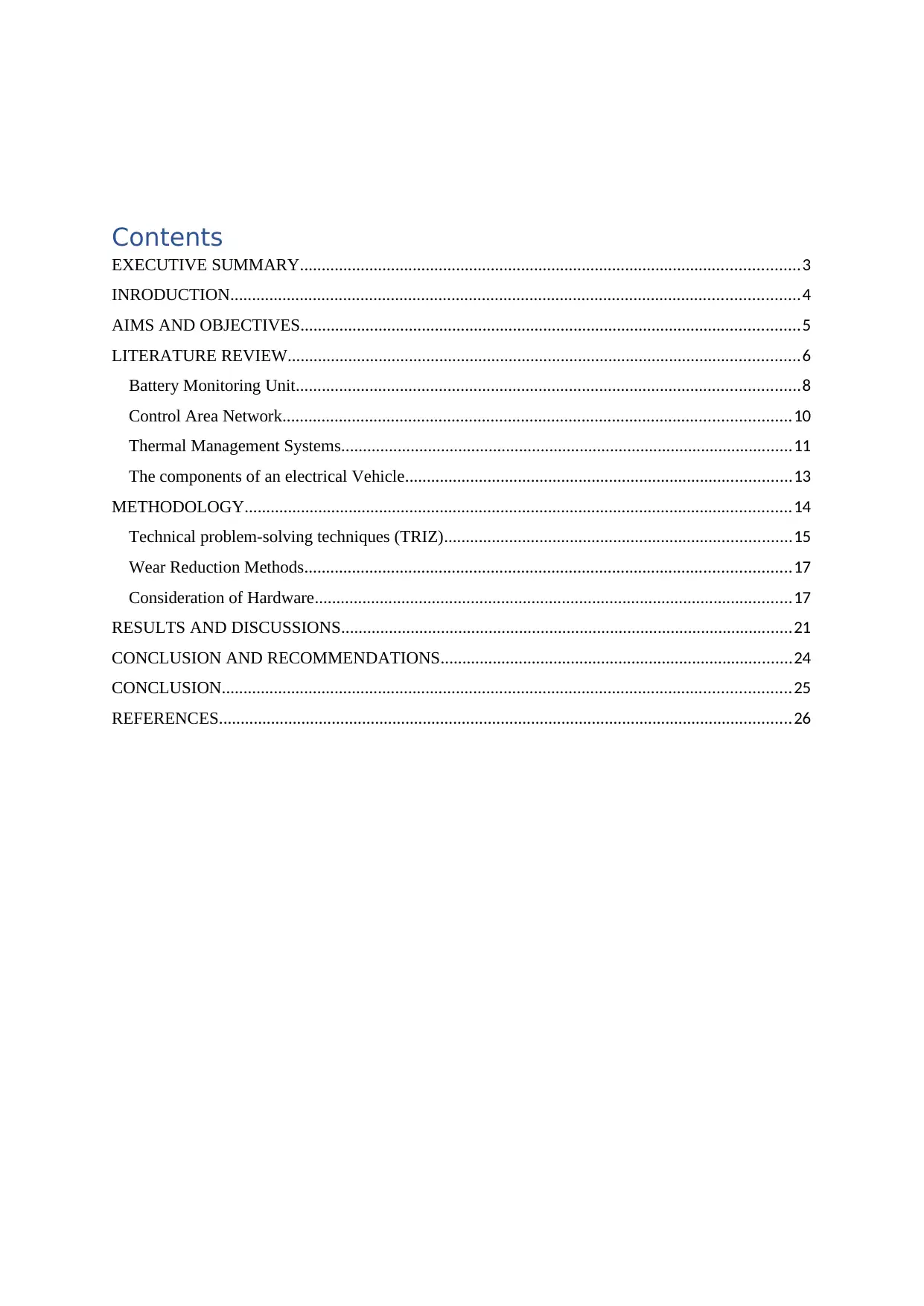
Contents
EXECUTIVE SUMMARY...................................................................................................................3
INRODUCTION...................................................................................................................................4
AIMS AND OBJECTIVES...................................................................................................................5
LITERATURE REVIEW......................................................................................................................6
Battery Monitoring Unit....................................................................................................................8
Control Area Network.....................................................................................................................10
Thermal Management Systems........................................................................................................11
The components of an electrical Vehicle.........................................................................................13
METHODOLOGY..............................................................................................................................14
Technical problem-solving techniques (TRIZ)................................................................................15
Wear Reduction Methods................................................................................................................17
Consideration of Hardware..............................................................................................................17
RESULTS AND DISCUSSIONS........................................................................................................21
CONCLUSION AND RECOMMENDATIONS.................................................................................24
CONCLUSION...................................................................................................................................25
REFERENCES....................................................................................................................................26
EXECUTIVE SUMMARY...................................................................................................................3
INRODUCTION...................................................................................................................................4
AIMS AND OBJECTIVES...................................................................................................................5
LITERATURE REVIEW......................................................................................................................6
Battery Monitoring Unit....................................................................................................................8
Control Area Network.....................................................................................................................10
Thermal Management Systems........................................................................................................11
The components of an electrical Vehicle.........................................................................................13
METHODOLOGY..............................................................................................................................14
Technical problem-solving techniques (TRIZ)................................................................................15
Wear Reduction Methods................................................................................................................17
Consideration of Hardware..............................................................................................................17
RESULTS AND DISCUSSIONS........................................................................................................21
CONCLUSION AND RECOMMENDATIONS.................................................................................24
CONCLUSION...................................................................................................................................25
REFERENCES....................................................................................................................................26
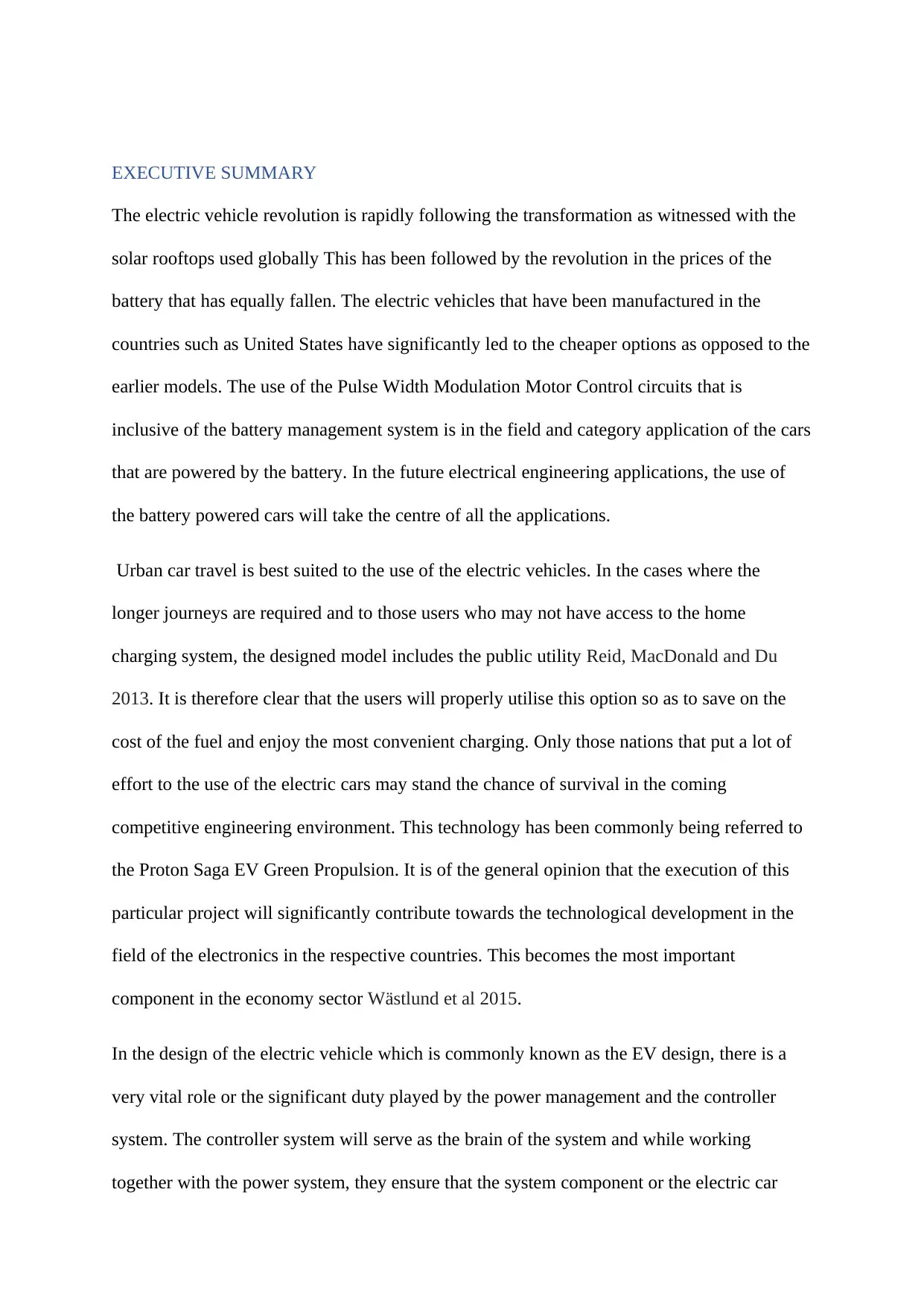
EXECUTIVE SUMMARY
The electric vehicle revolution is rapidly following the transformation as witnessed with the
solar rooftops used globally This has been followed by the revolution in the prices of the
battery that has equally fallen. The electric vehicles that have been manufactured in the
countries such as United States have significantly led to the cheaper options as opposed to the
earlier models. The use of the Pulse Width Modulation Motor Control circuits that is
inclusive of the battery management system is in the field and category application of the cars
that are powered by the battery. In the future electrical engineering applications, the use of
the battery powered cars will take the centre of all the applications.
Urban car travel is best suited to the use of the electric vehicles. In the cases where the
longer journeys are required and to those users who may not have access to the home
charging system, the designed model includes the public utility Reid, MacDonald and Du
2013. It is therefore clear that the users will properly utilise this option so as to save on the
cost of the fuel and enjoy the most convenient charging. Only those nations that put a lot of
effort to the use of the electric cars may stand the chance of survival in the coming
competitive engineering environment. This technology has been commonly being referred to
the Proton Saga EV Green Propulsion. It is of the general opinion that the execution of this
particular project will significantly contribute towards the technological development in the
field of the electronics in the respective countries. This becomes the most important
component in the economy sector Wästlund et al 2015.
In the design of the electric vehicle which is commonly known as the EV design, there is a
very vital role or the significant duty played by the power management and the controller
system. The controller system will serve as the brain of the system and while working
together with the power system, they ensure that the system component or the electric car
The electric vehicle revolution is rapidly following the transformation as witnessed with the
solar rooftops used globally This has been followed by the revolution in the prices of the
battery that has equally fallen. The electric vehicles that have been manufactured in the
countries such as United States have significantly led to the cheaper options as opposed to the
earlier models. The use of the Pulse Width Modulation Motor Control circuits that is
inclusive of the battery management system is in the field and category application of the cars
that are powered by the battery. In the future electrical engineering applications, the use of
the battery powered cars will take the centre of all the applications.
Urban car travel is best suited to the use of the electric vehicles. In the cases where the
longer journeys are required and to those users who may not have access to the home
charging system, the designed model includes the public utility Reid, MacDonald and Du
2013. It is therefore clear that the users will properly utilise this option so as to save on the
cost of the fuel and enjoy the most convenient charging. Only those nations that put a lot of
effort to the use of the electric cars may stand the chance of survival in the coming
competitive engineering environment. This technology has been commonly being referred to
the Proton Saga EV Green Propulsion. It is of the general opinion that the execution of this
particular project will significantly contribute towards the technological development in the
field of the electronics in the respective countries. This becomes the most important
component in the economy sector Wästlund et al 2015.
In the design of the electric vehicle which is commonly known as the EV design, there is a
very vital role or the significant duty played by the power management and the controller
system. The controller system will serve as the brain of the system and while working
together with the power system, they ensure that the system component or the electric car
⊘ This is a preview!⊘
Do you want full access?
Subscribe today to unlock all pages.

Trusted by 1+ million students worldwide
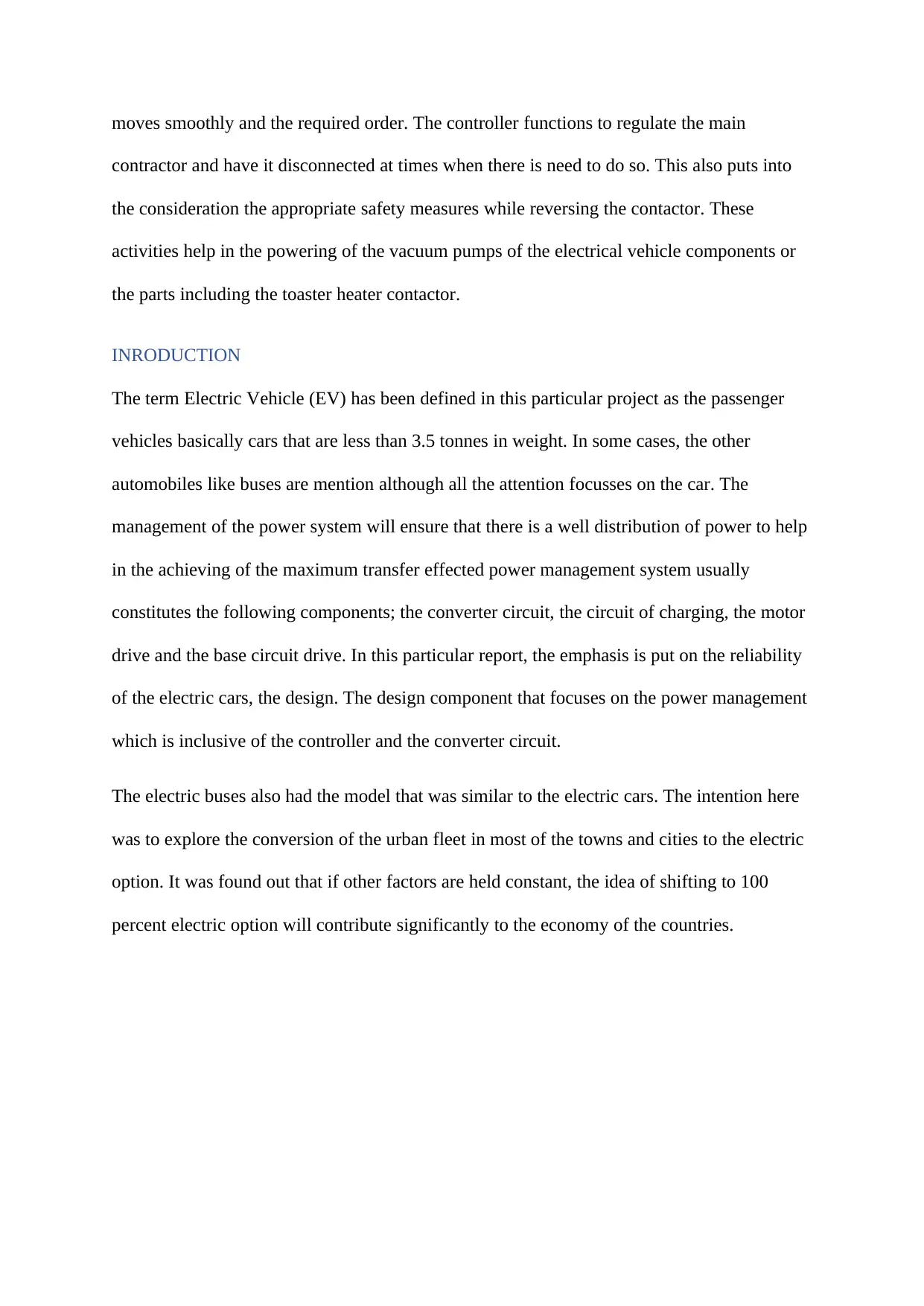
moves smoothly and the required order. The controller functions to regulate the main
contractor and have it disconnected at times when there is need to do so. This also puts into
the consideration the appropriate safety measures while reversing the contactor. These
activities help in the powering of the vacuum pumps of the electrical vehicle components or
the parts including the toaster heater contactor.
INRODUCTION
The term Electric Vehicle (EV) has been defined in this particular project as the passenger
vehicles basically cars that are less than 3.5 tonnes in weight. In some cases, the other
automobiles like buses are mention although all the attention focusses on the car. The
management of the power system will ensure that there is a well distribution of power to help
in the achieving of the maximum transfer effected power management system usually
constitutes the following components; the converter circuit, the circuit of charging, the motor
drive and the base circuit drive. In this particular report, the emphasis is put on the reliability
of the electric cars, the design. The design component that focuses on the power management
which is inclusive of the controller and the converter circuit.
The electric buses also had the model that was similar to the electric cars. The intention here
was to explore the conversion of the urban fleet in most of the towns and cities to the electric
option. It was found out that if other factors are held constant, the idea of shifting to 100
percent electric option will contribute significantly to the economy of the countries.
contractor and have it disconnected at times when there is need to do so. This also puts into
the consideration the appropriate safety measures while reversing the contactor. These
activities help in the powering of the vacuum pumps of the electrical vehicle components or
the parts including the toaster heater contactor.
INRODUCTION
The term Electric Vehicle (EV) has been defined in this particular project as the passenger
vehicles basically cars that are less than 3.5 tonnes in weight. In some cases, the other
automobiles like buses are mention although all the attention focusses on the car. The
management of the power system will ensure that there is a well distribution of power to help
in the achieving of the maximum transfer effected power management system usually
constitutes the following components; the converter circuit, the circuit of charging, the motor
drive and the base circuit drive. In this particular report, the emphasis is put on the reliability
of the electric cars, the design. The design component that focuses on the power management
which is inclusive of the controller and the converter circuit.
The electric buses also had the model that was similar to the electric cars. The intention here
was to explore the conversion of the urban fleet in most of the towns and cities to the electric
option. It was found out that if other factors are held constant, the idea of shifting to 100
percent electric option will contribute significantly to the economy of the countries.
Paraphrase This Document
Need a fresh take? Get an instant paraphrase of this document with our AI Paraphraser
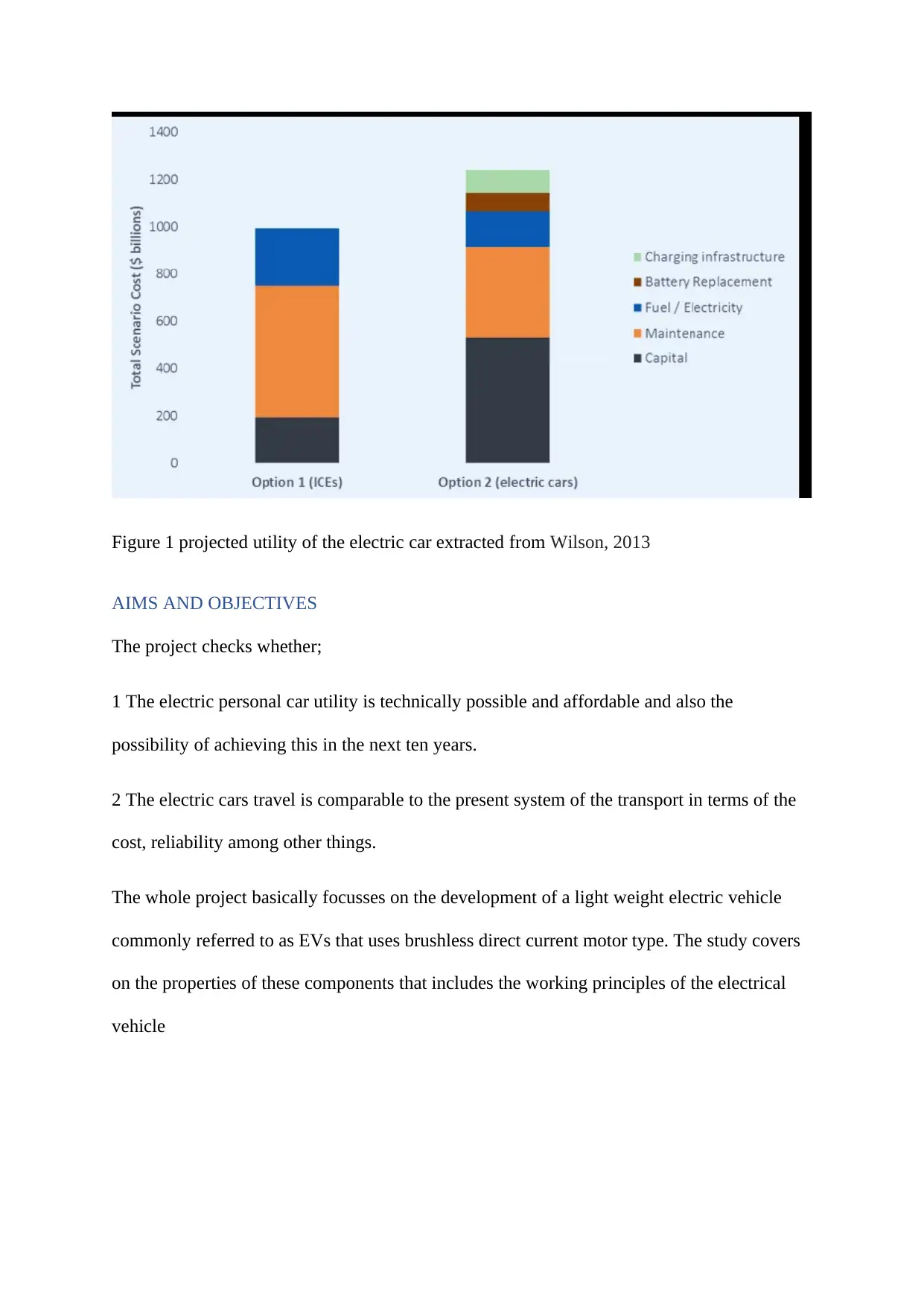
Figure 1 projected utility of the electric car extracted from Wilson, 2013
AIMS AND OBJECTIVES
The project checks whether;
1 The electric personal car utility is technically possible and affordable and also the
possibility of achieving this in the next ten years.
2 The electric cars travel is comparable to the present system of the transport in terms of the
cost, reliability among other things.
The whole project basically focusses on the development of a light weight electric vehicle
commonly referred to as EVs that uses brushless direct current motor type. The study covers
on the properties of these components that includes the working principles of the electrical
vehicle
AIMS AND OBJECTIVES
The project checks whether;
1 The electric personal car utility is technically possible and affordable and also the
possibility of achieving this in the next ten years.
2 The electric cars travel is comparable to the present system of the transport in terms of the
cost, reliability among other things.
The whole project basically focusses on the development of a light weight electric vehicle
commonly referred to as EVs that uses brushless direct current motor type. The study covers
on the properties of these components that includes the working principles of the electrical
vehicle
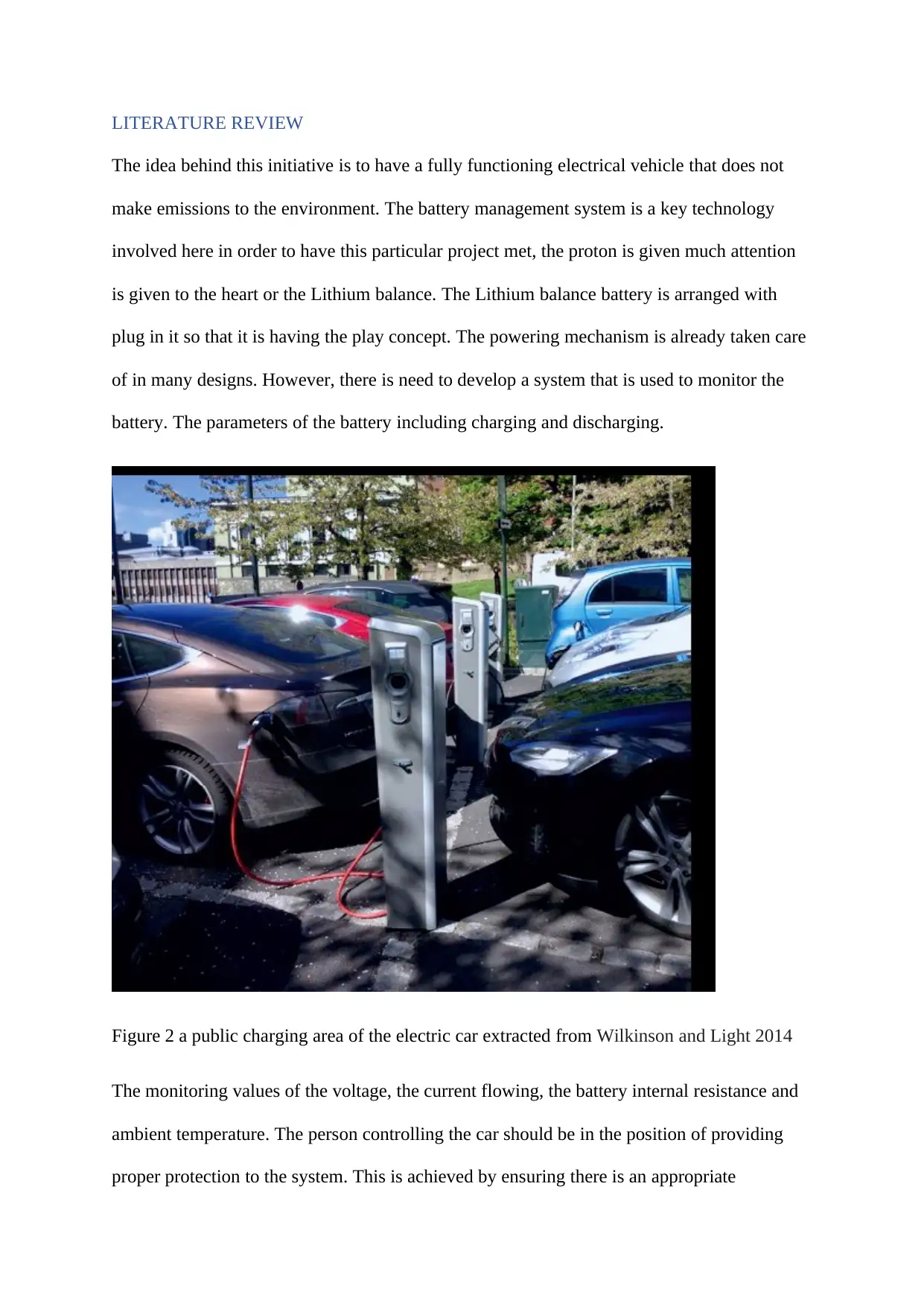
LITERATURE REVIEW
The idea behind this initiative is to have a fully functioning electrical vehicle that does not
make emissions to the environment. The battery management system is a key technology
involved here in order to have this particular project met, the proton is given much attention
is given to the heart or the Lithium balance. The Lithium balance battery is arranged with
plug in it so that it is having the play concept. The powering mechanism is already taken care
of in many designs. However, there is need to develop a system that is used to monitor the
battery. The parameters of the battery including charging and discharging.
Figure 2 a public charging area of the electric car extracted from Wilkinson and Light 2014
The monitoring values of the voltage, the current flowing, the battery internal resistance and
ambient temperature. The person controlling the car should be in the position of providing
proper protection to the system. This is achieved by ensuring there is an appropriate
The idea behind this initiative is to have a fully functioning electrical vehicle that does not
make emissions to the environment. The battery management system is a key technology
involved here in order to have this particular project met, the proton is given much attention
is given to the heart or the Lithium balance. The Lithium balance battery is arranged with
plug in it so that it is having the play concept. The powering mechanism is already taken care
of in many designs. However, there is need to develop a system that is used to monitor the
battery. The parameters of the battery including charging and discharging.
Figure 2 a public charging area of the electric car extracted from Wilkinson and Light 2014
The monitoring values of the voltage, the current flowing, the battery internal resistance and
ambient temperature. The person controlling the car should be in the position of providing
proper protection to the system. This is achieved by ensuring there is an appropriate
⊘ This is a preview!⊘
Do you want full access?
Subscribe today to unlock all pages.

Trusted by 1+ million students worldwide
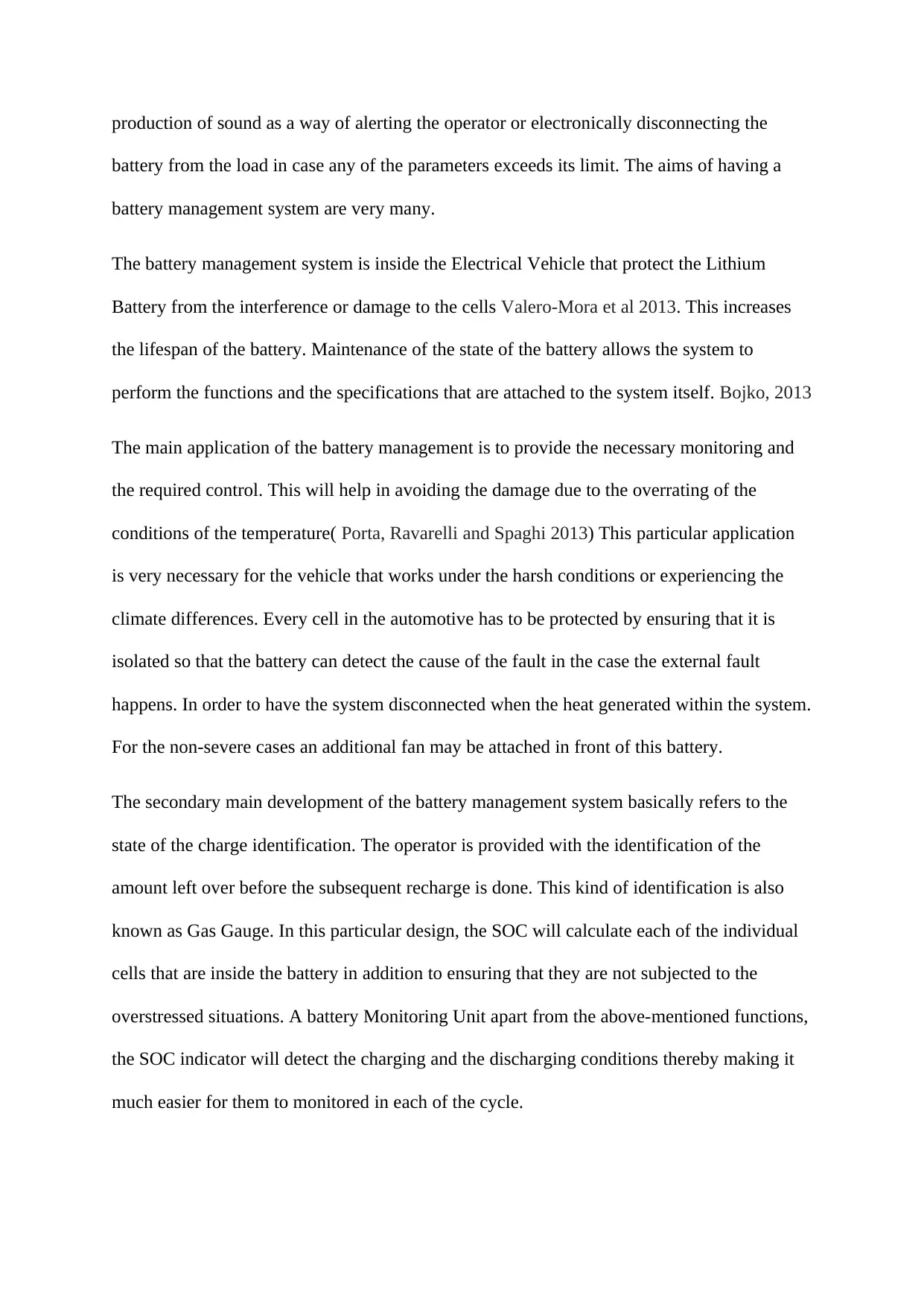
production of sound as a way of alerting the operator or electronically disconnecting the
battery from the load in case any of the parameters exceeds its limit. The aims of having a
battery management system are very many.
The battery management system is inside the Electrical Vehicle that protect the Lithium
Battery from the interference or damage to the cells Valero-Mora et al 2013. This increases
the lifespan of the battery. Maintenance of the state of the battery allows the system to
perform the functions and the specifications that are attached to the system itself. Bojko, 2013
The main application of the battery management is to provide the necessary monitoring and
the required control. This will help in avoiding the damage due to the overrating of the
conditions of the temperature( Porta, Ravarelli and Spaghi 2013) This particular application
is very necessary for the vehicle that works under the harsh conditions or experiencing the
climate differences. Every cell in the automotive has to be protected by ensuring that it is
isolated so that the battery can detect the cause of the fault in the case the external fault
happens. In order to have the system disconnected when the heat generated within the system.
For the non-severe cases an additional fan may be attached in front of this battery.
The secondary main development of the battery management system basically refers to the
state of the charge identification. The operator is provided with the identification of the
amount left over before the subsequent recharge is done. This kind of identification is also
known as Gas Gauge. In this particular design, the SOC will calculate each of the individual
cells that are inside the battery in addition to ensuring that they are not subjected to the
overstressed situations. A battery Monitoring Unit apart from the above-mentioned functions,
the SOC indicator will detect the charging and the discharging conditions thereby making it
much easier for them to monitored in each of the cycle.
battery from the load in case any of the parameters exceeds its limit. The aims of having a
battery management system are very many.
The battery management system is inside the Electrical Vehicle that protect the Lithium
Battery from the interference or damage to the cells Valero-Mora et al 2013. This increases
the lifespan of the battery. Maintenance of the state of the battery allows the system to
perform the functions and the specifications that are attached to the system itself. Bojko, 2013
The main application of the battery management is to provide the necessary monitoring and
the required control. This will help in avoiding the damage due to the overrating of the
conditions of the temperature( Porta, Ravarelli and Spaghi 2013) This particular application
is very necessary for the vehicle that works under the harsh conditions or experiencing the
climate differences. Every cell in the automotive has to be protected by ensuring that it is
isolated so that the battery can detect the cause of the fault in the case the external fault
happens. In order to have the system disconnected when the heat generated within the system.
For the non-severe cases an additional fan may be attached in front of this battery.
The secondary main development of the battery management system basically refers to the
state of the charge identification. The operator is provided with the identification of the
amount left over before the subsequent recharge is done. This kind of identification is also
known as Gas Gauge. In this particular design, the SOC will calculate each of the individual
cells that are inside the battery in addition to ensuring that they are not subjected to the
overstressed situations. A battery Monitoring Unit apart from the above-mentioned functions,
the SOC indicator will detect the charging and the discharging conditions thereby making it
much easier for them to monitored in each of the cycle.
Paraphrase This Document
Need a fresh take? Get an instant paraphrase of this document with our AI Paraphraser
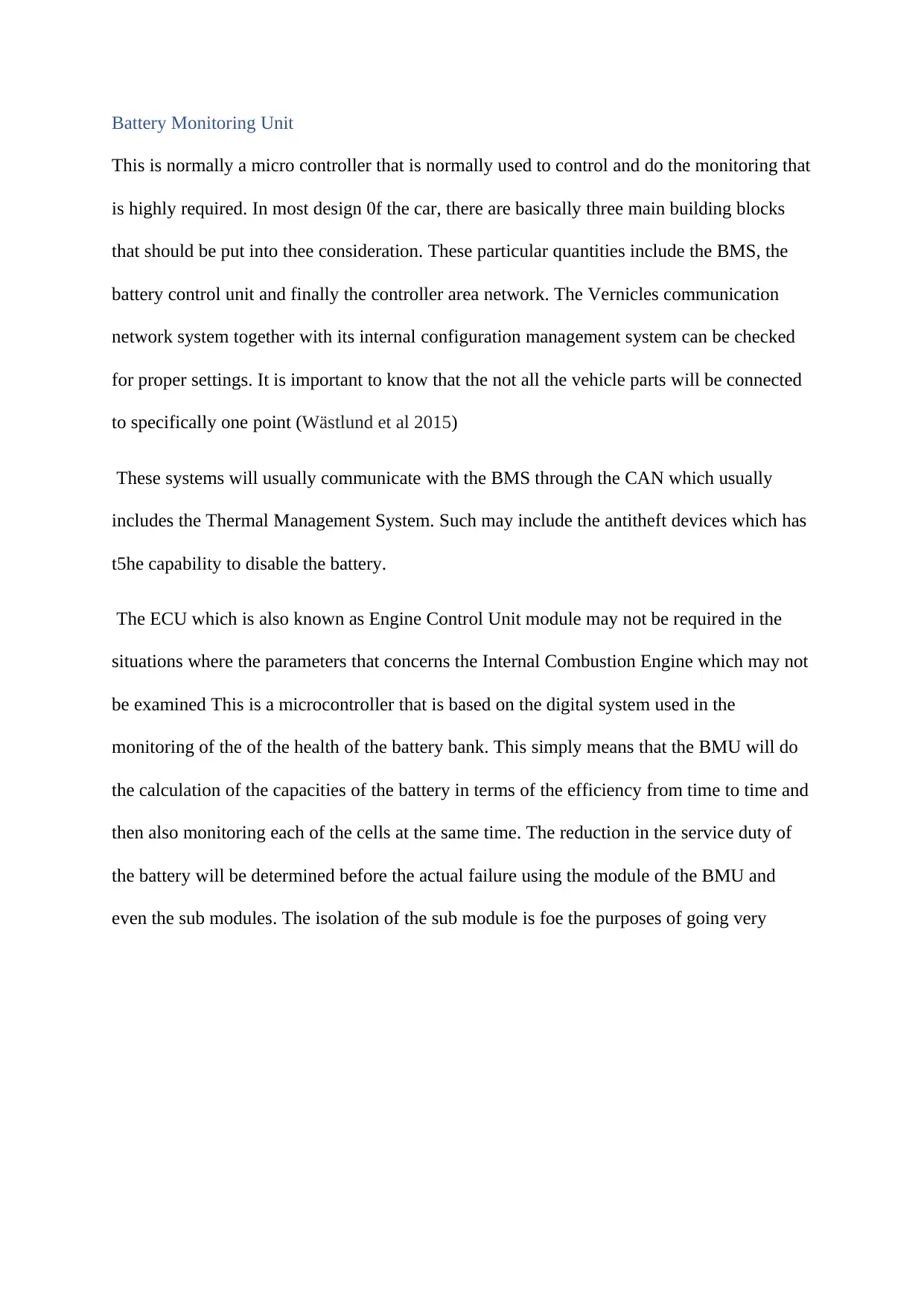
Battery Monitoring Unit
This is normally a micro controller that is normally used to control and do the monitoring that
is highly required. In most design 0f the car, there are basically three main building blocks
that should be put into thee consideration. These particular quantities include the BMS, the
battery control unit and finally the controller area network. The Vernicles communication
network system together with its internal configuration management system can be checked
for proper settings. It is important to know that the not all the vehicle parts will be connected
to specifically one point (Wästlund et al 2015)
These systems will usually communicate with the BMS through the CAN which usually
includes the Thermal Management System. Such may include the antitheft devices which has
t5he capability to disable the battery.
The ECU which is also known as Engine Control Unit module may not be required in the
situations where the parameters that concerns the Internal Combustion Engine which may not
be examined This is a microcontroller that is based on the digital system used in the
monitoring of the of the health of the battery bank. This simply means that the BMU will do
the calculation of the capacities of the battery in terms of the efficiency from time to time and
then also monitoring each of the cells at the same time. The reduction in the service duty of
the battery will be determined before the actual failure using the module of the BMU and
even the sub modules. The isolation of the sub module is foe the purposes of going very
This is normally a micro controller that is normally used to control and do the monitoring that
is highly required. In most design 0f the car, there are basically three main building blocks
that should be put into thee consideration. These particular quantities include the BMS, the
battery control unit and finally the controller area network. The Vernicles communication
network system together with its internal configuration management system can be checked
for proper settings. It is important to know that the not all the vehicle parts will be connected
to specifically one point (Wästlund et al 2015)
These systems will usually communicate with the BMS through the CAN which usually
includes the Thermal Management System. Such may include the antitheft devices which has
t5he capability to disable the battery.
The ECU which is also known as Engine Control Unit module may not be required in the
situations where the parameters that concerns the Internal Combustion Engine which may not
be examined This is a microcontroller that is based on the digital system used in the
monitoring of the of the health of the battery bank. This simply means that the BMU will do
the calculation of the capacities of the battery in terms of the efficiency from time to time and
then also monitoring each of the cells at the same time. The reduction in the service duty of
the battery will be determined before the actual failure using the module of the BMU and
even the sub modules. The isolation of the sub module is foe the purposes of going very
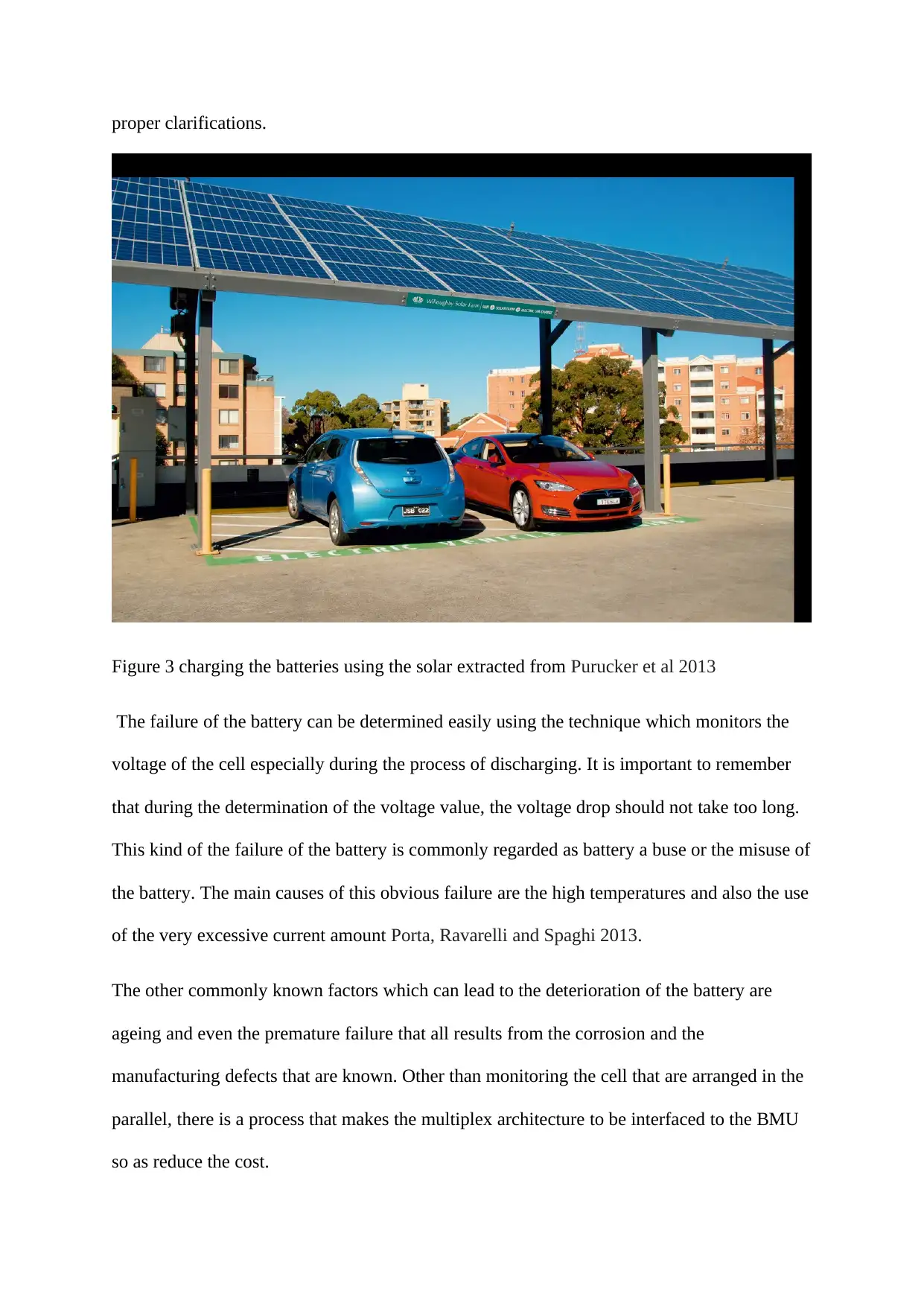
proper clarifications.
Figure 3 charging the batteries using the solar extracted from Purucker et al 2013
The failure of the battery can be determined easily using the technique which monitors the
voltage of the cell especially during the process of discharging. It is important to remember
that during the determination of the voltage value, the voltage drop should not take too long.
This kind of the failure of the battery is commonly regarded as battery a buse or the misuse of
the battery. The main causes of this obvious failure are the high temperatures and also the use
of the very excessive current amount Porta, Ravarelli and Spaghi 2013.
The other commonly known factors which can lead to the deterioration of the battery are
ageing and even the premature failure that all results from the corrosion and the
manufacturing defects that are known. Other than monitoring the cell that are arranged in the
parallel, there is a process that makes the multiplex architecture to be interfaced to the BMU
so as reduce the cost.
Figure 3 charging the batteries using the solar extracted from Purucker et al 2013
The failure of the battery can be determined easily using the technique which monitors the
voltage of the cell especially during the process of discharging. It is important to remember
that during the determination of the voltage value, the voltage drop should not take too long.
This kind of the failure of the battery is commonly regarded as battery a buse or the misuse of
the battery. The main causes of this obvious failure are the high temperatures and also the use
of the very excessive current amount Porta, Ravarelli and Spaghi 2013.
The other commonly known factors which can lead to the deterioration of the battery are
ageing and even the premature failure that all results from the corrosion and the
manufacturing defects that are known. Other than monitoring the cell that are arranged in the
parallel, there is a process that makes the multiplex architecture to be interfaced to the BMU
so as reduce the cost.
⊘ This is a preview!⊘
Do you want full access?
Subscribe today to unlock all pages.

Trusted by 1+ million students worldwide
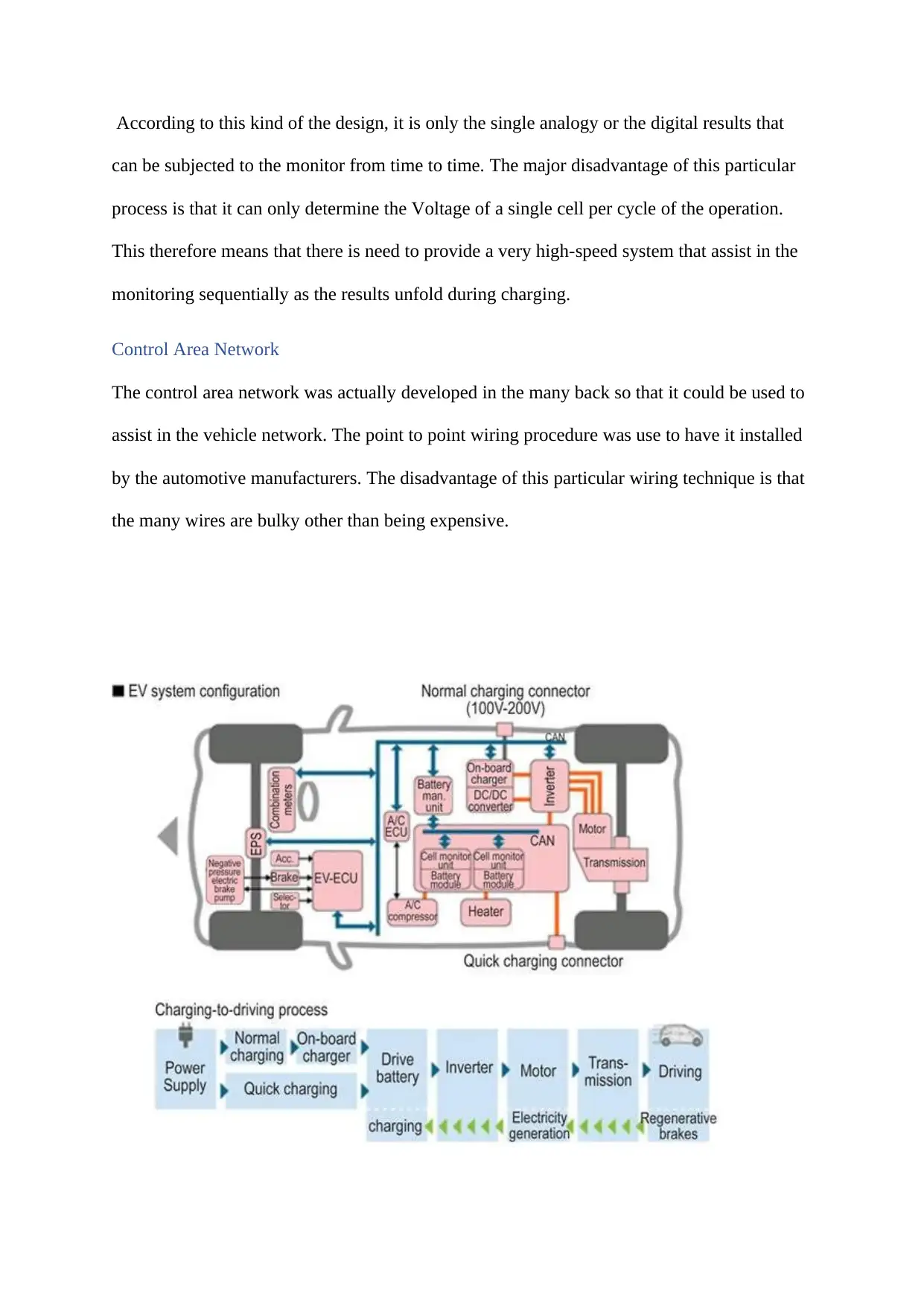
According to this kind of the design, it is only the single analogy or the digital results that
can be subjected to the monitor from time to time. The major disadvantage of this particular
process is that it can only determine the Voltage of a single cell per cycle of the operation.
This therefore means that there is need to provide a very high-speed system that assist in the
monitoring sequentially as the results unfold during charging.
Control Area Network
The control area network was actually developed in the many back so that it could be used to
assist in the vehicle network. The point to point wiring procedure was use to have it installed
by the automotive manufacturers. The disadvantage of this particular wiring technique is that
the many wires are bulky other than being expensive.
can be subjected to the monitor from time to time. The major disadvantage of this particular
process is that it can only determine the Voltage of a single cell per cycle of the operation.
This therefore means that there is need to provide a very high-speed system that assist in the
monitoring sequentially as the results unfold during charging.
Control Area Network
The control area network was actually developed in the many back so that it could be used to
assist in the vehicle network. The point to point wiring procedure was use to have it installed
by the automotive manufacturers. The disadvantage of this particular wiring technique is that
the many wires are bulky other than being expensive.
Paraphrase This Document
Need a fresh take? Get an instant paraphrase of this document with our AI Paraphraser
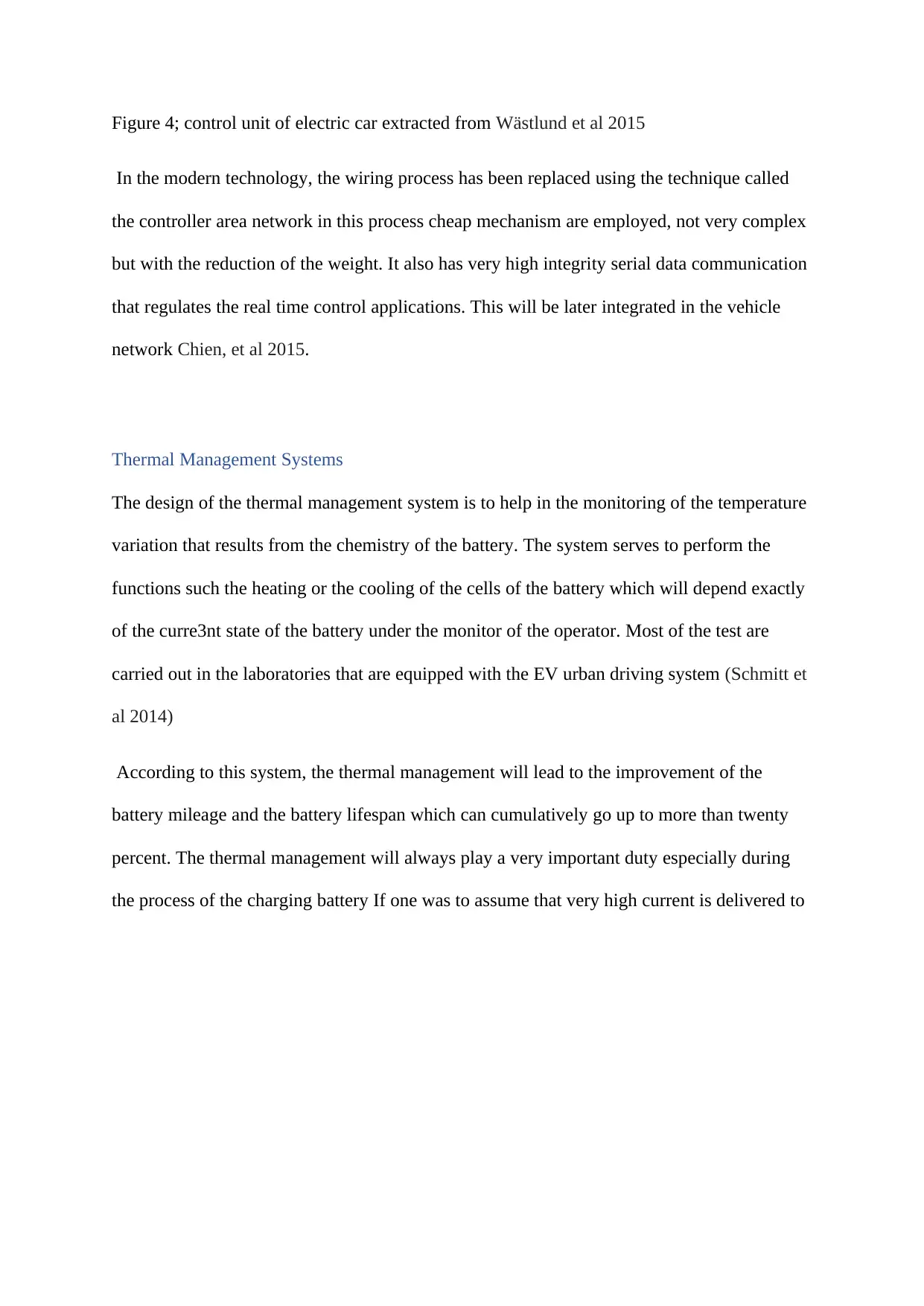
Figure 4; control unit of electric car extracted from Wästlund et al 2015
In the modern technology, the wiring process has been replaced using the technique called
the controller area network in this process cheap mechanism are employed, not very complex
but with the reduction of the weight. It also has very high integrity serial data communication
that regulates the real time control applications. This will be later integrated in the vehicle
network Chien, et al 2015.
Thermal Management Systems
The design of the thermal management system is to help in the monitoring of the temperature
variation that results from the chemistry of the battery. The system serves to perform the
functions such the heating or the cooling of the cells of the battery which will depend exactly
of the curre3nt state of the battery under the monitor of the operator. Most of the test are
carried out in the laboratories that are equipped with the EV urban driving system (Schmitt et
al 2014)
According to this system, the thermal management will lead to the improvement of the
battery mileage and the battery lifespan which can cumulatively go up to more than twenty
percent. The thermal management will always play a very important duty especially during
the process of the charging battery If one was to assume that very high current is delivered to
In the modern technology, the wiring process has been replaced using the technique called
the controller area network in this process cheap mechanism are employed, not very complex
but with the reduction of the weight. It also has very high integrity serial data communication
that regulates the real time control applications. This will be later integrated in the vehicle
network Chien, et al 2015.
Thermal Management Systems
The design of the thermal management system is to help in the monitoring of the temperature
variation that results from the chemistry of the battery. The system serves to perform the
functions such the heating or the cooling of the cells of the battery which will depend exactly
of the curre3nt state of the battery under the monitor of the operator. Most of the test are
carried out in the laboratories that are equipped with the EV urban driving system (Schmitt et
al 2014)
According to this system, the thermal management will lead to the improvement of the
battery mileage and the battery lifespan which can cumulatively go up to more than twenty
percent. The thermal management will always play a very important duty especially during
the process of the charging battery If one was to assume that very high current is delivered to

Figure 5; heat control system of electric car extracted from Ohm et al 2014.
the system of the EV, the temperature issues will be very obvious. The initial stages of the
design protect the battery from the external interference. The insulation process therefore
assists in the enhancing of the generation of the heat during the winter and even the summer
seasons. In the second criteria of the design, the flow of the air has been made possible to
maximise the circulation which later assist in the lowering of the temperature and therefore
achieving the equilibrium the surrounding and the battery itself. The type of the design that is
affected by the environment will be dependent on the prevailing conditions of the
environment where the car is to be operated.
the system of the EV, the temperature issues will be very obvious. The initial stages of the
design protect the battery from the external interference. The insulation process therefore
assists in the enhancing of the generation of the heat during the winter and even the summer
seasons. In the second criteria of the design, the flow of the air has been made possible to
maximise the circulation which later assist in the lowering of the temperature and therefore
achieving the equilibrium the surrounding and the battery itself. The type of the design that is
affected by the environment will be dependent on the prevailing conditions of the
environment where the car is to be operated.
⊘ This is a preview!⊘
Do you want full access?
Subscribe today to unlock all pages.

Trusted by 1+ million students worldwide
1 out of 29
Related Documents
Your All-in-One AI-Powered Toolkit for Academic Success.
+13062052269
info@desklib.com
Available 24*7 on WhatsApp / Email
![[object Object]](/_next/static/media/star-bottom.7253800d.svg)
Unlock your academic potential
Copyright © 2020–2025 A2Z Services. All Rights Reserved. Developed and managed by ZUCOL.





